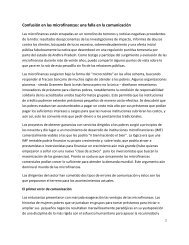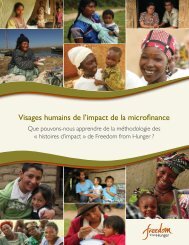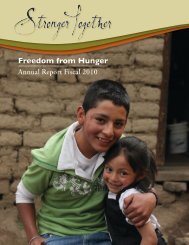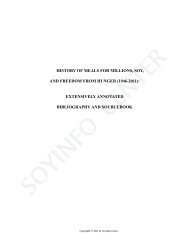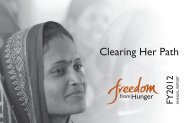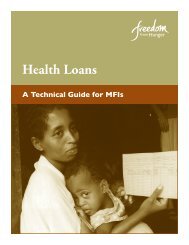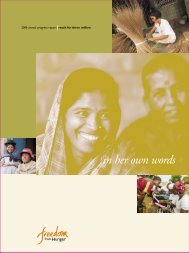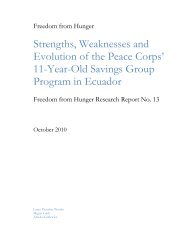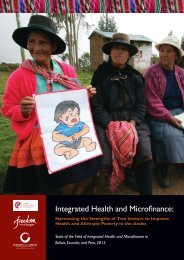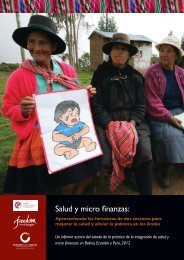English - Freedom from Hunger
English - Freedom from Hunger
English - Freedom from Hunger
You also want an ePaper? Increase the reach of your titles
YUMPU automatically turns print PDFs into web optimized ePapers that Google loves.
Painting a Picture<br />
PaInTIng a PICTuRe<br />
These four stories and the remaining 270 stories we collected paint a picture of the hope that women and<br />
men bring to their microfinance experiences. The 274 individuals (250 women and 24 men) representing<br />
the nine programs around the world enter their local microfinance program <strong>from</strong> a variety of backgrounds<br />
and family situations and have different ways of thinking about their immediate situations, yet almost all<br />
have some hope that their participation in the program will mean an improvement in their lives.<br />
Our discussions with program participants about their views on what constitutes “well-being,” their<br />
assessments of the changing opportunities across the generations, and their thoughts about their families’<br />
health and nutrition, provide for us a small window through which we can get a glimpse of their needs,<br />
hopes and dreams. The knowledge that we gain <strong>from</strong> these conversations provides a backdrop for<br />
understanding the true impact of value-added microfinance and humanizes the men and women, families<br />
and communities that participate in microfinance.<br />
The Good Life<br />
Across all nine programs, when asked about their definition of “the good life,” most members spoke about<br />
“the good life” (or well-being) and good health almost interchangeably. That is, for these microfinance<br />
program members, it is not unusual to think about their own well-being in terms of the ability to stay<br />
healthy and to see a doctor when necessary. For participants in all nine programs, well-being is also<br />
associated with the ability to work and earn money.<br />
Gulenur, <strong>from</strong> India, is married with three children—two daughters and one son. She is an active contributor to<br />
her family’s income, as she is involved with her husband in the jari business. To her, well-being is “having [a] sufficient<br />
amount of money, presence and support of [my] husband, supportive in-laws, no conflict and love among family<br />
members.” Her only dream is that she is able to educate her children so that they can be financially independent<br />
and capable of running their own establishments.<br />
A majority of individuals also commented on the association between well-being or good health and<br />
access to healthy or good-quality food, or the availability of sufficient quantities of food. In Mali, Bénin<br />
and Burkina Faso, several program participants also suggested that proper hygiene or cleanliness were<br />
relevant to their well-being or good health.<br />
Although most participants did not refer to specific material goods in the context of well-being, some<br />
of those interviewed did. At least a couple of individuals in each of the Bolivia, Peru, Ecuador, Burkina<br />
Faso, Bénin and Mali programs said that well-being or the good life depends on having a decent house.<br />
Individuals in Bénin and Mali mentioned that they need sufficient clothing for the family before they can<br />
say that they are in a state of well-being.<br />
But for most, the concepts of well-being and good health go to the core of their lives for microfinance<br />
program members—the absence of disease, having the ability to work and access to decent food.<br />
10



